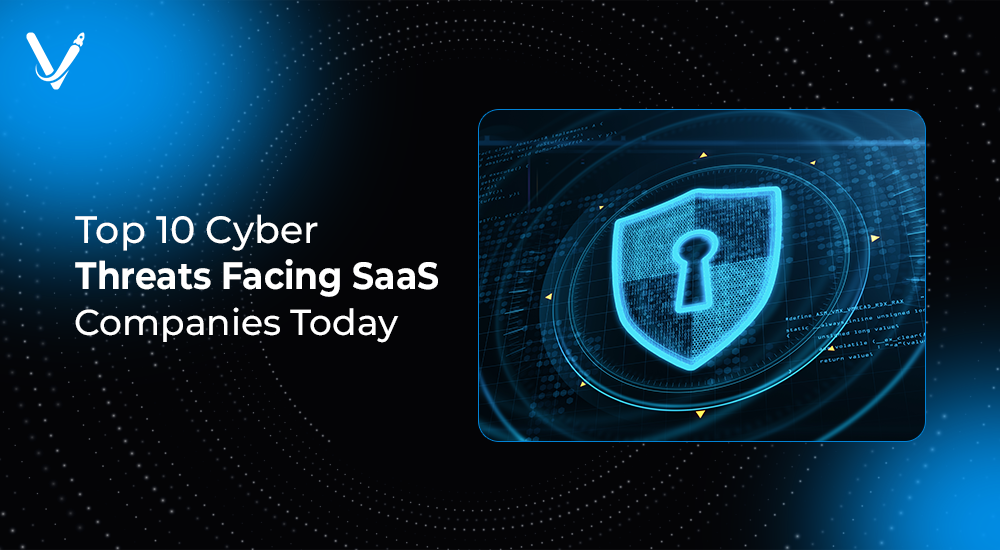Top 10 Cyber Threats Facing SaaS Companies Today


- Jun 28, 2025
In today’s cloud-powered economy, Software-as-a-Service (SaaS) has emerged as the backbone of digital operations. Businesses of every size—from startups to Fortune 500 giants—rely on SaaS platforms to manage everything from payroll and communication to customer relationships and data analytics. This reliance has created a new battlefield: cybersecurity in SaaS.
As SaaS adoption accelerates, so does the volume and sophistication of cyber threats targeting SaaS platforms. These aren’t just abstract risks. Data breaches, ransomware attacks, and insider threats have the potential to destroy customer trust, invite regulatory fines, and cause irreparable brand damage. To stay competitive, SaaS companies must be just as agile in their security strategies as they are in their development practices.
In this comprehensive guide, we unpack the top 10 cyber threats that SaaS providers face today and explore best practices to detect, prevent, and respond to these ever-evolving risks.
A single misconfiguration in cloud settings can lead to massive data exposure. Many SaaS platforms use public cloud services like AWS, Azure, or Google Cloud. While these platforms offer robust security, responsibility for configuration lies with the SaaS company.
In 2023, an Australian SaaS firm accidentally exposed customer billing data when an AWS S3 bucket was misconfigured to be public. This breach affected over 400,000 users and led to severe reputational loss.
Modern SaaS platforms thrive on integration. However, insecure APIs and unvetted third-party add-ons introduce vulnerabilities hackers can exploit to gain unauthorized access.
An attacker exploited an unsecured webhook in a CRM SaaS tool in 2024, injecting malicious commands into a customer’s internal network. The vendor had no validation or rate limiting in place.
Insider threats are increasingly dangerous due to remote work models and global teams. Disgruntled employees, careless contractors, or compromised staff credentials can lead to data leaks or system sabotage.
A former employee at a SaaS HR platform exported thousands of sensitive resumes after access revocation was delayed post-termination.
Users often reuse passwords. Cybercriminals leverage leaked credentials to perform automated login attempts across SaaS platforms. This threat, known as credential stuffing, is highly effective if multi-factor authentication (MFA) is not enforced.
In 2024, attackers gained control over multiple high-value customer accounts on a billing SaaS app using previously leaked credentials. The breach exposed financial records and invoice histories.
Unlike traditional ransomware, modern variants target cloud backups and storage APIs. SaaS providers are increasingly targeted with ransom demands for encrypted data or threats of exposure.
According to a 2025 IBM report, 32% of ransomware attacks now target cloud-hosted SaaS data, a 48% increase from 2023.
Employees often connect unauthorized apps to SaaS tools like Slack, Google Workspace, or Trello. These shadow IT integrations can leak sensitive business data through non-compliant services.
A mid-sized SaaS project management platform discovered a rogue Chrome extension used by several users that had access to project metadata and passwords.
Modern SaaS platforms depend heavily on open-source libraries and CI/CD pipelines. Software supply chain attacks target these dependencies to inject malicious code into live environments.
The SolarWinds attack in 2020 was a harbinger. In 2024, a JavaScript package used by hundreds of SaaS dashboards was discovered to contain a crypto-miner injected via a compromised contributor account.
Many smaller SaaS vendors skip full data encryption to save costs or reduce latency. However, unsecured data in transit or at rest can be intercepted or copied in case of unauthorized access.
A backup system for a SaaS education platform transmitted student data over unencrypted HTTP, which was intercepted by a man-in-the-middle (MitM) attack during a public Wi-Fi session.
SaaS platforms are lucrative targets for phishing. Attackers send deceptive emails to trick users or support staff into giving up credentials or executing malicious actions.
A spear-phishing campaign in 2024 mimicked a well-known invoicing SaaS tool. Victims who clicked the link saw a clone login page, leading to stolen account access.
SaaS platforms often serve global clients, which means navigating GDPR, CCPA, HIPAA, and now DPDP (India’s Digital Personal Data Protection Act). Violating compliance can trigger multimillion-dollar penalties.
In 2023, a healthcare SaaS firm was fined $1.2 million for storing EU patient data on U.S. servers without explicit consent or data processing agreements.
While threats evolve, so can your defense. Here's how SaaS companies can stay ahead:
Cyber threats are no longer just IT concerns—they are product concerns, customer trust issues, and boardroom-level priorities. In today’s digital landscape, security must be built-in, not bolted-on. By proactively identifying and mitigating these top 10 cyber threats, SaaS companies can not only protect their users and data but also gain a competitive edge in a market that increasingly values privacy, trust, and compliance.
At Vasundhara Infotech, we help SaaS companies engineer secure, scalable, and intelligent platforms. Whether you're planning a new SaaS product or want to harden your existing infrastructure, our team brings expertise in cloud security, AI-driven threat detection, and compliance frameworks.
Secure your future—before someone else compromises it.
Get in touch with us today for a free consultation.
Copyright © 2025 Vasundhara Infotech. All Rights Reserved.
